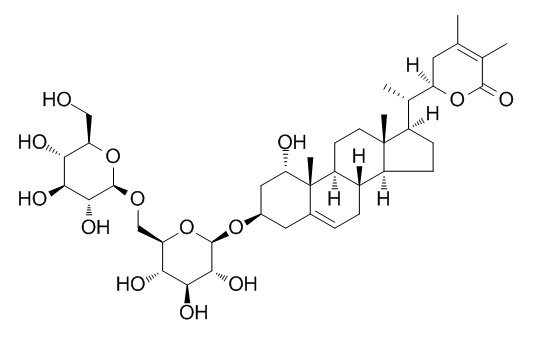Withanoside V
Reference standards.
Inquire / Order:
manager@chemfaces.com
Technical Inquiries:
service@chemfaces.com
Tel:
+86-27-84237783
Fax:
+86-27-84254680
Address:
1 Building, No. 83, CheCheng Rd., Wuhan Economic and Technological Development Zone, Wuhan, Hubei 430056, PRC
Providing storage is as stated on the product vial and the vial is kept tightly sealed, the product can be stored for up to
24 months(2-8C).
Wherever possible, you should prepare and use solutions on the same day. However, if you need to make up stock solutions in advance, we recommend that you store the solution as aliquots in tightly sealed vials at -20C. Generally, these will be useable for up to two weeks. Before use, and prior to opening the vial we recommend that you allow your product to equilibrate to room temperature for at least 1 hour.
Need more advice on solubility, usage and handling? Please email to: service@chemfaces.com
The packaging of the product may have turned upside down during transportation, resulting in the natural compounds adhering to the neck or cap of the vial. take the vial out of its packaging and gently shake to let the compounds fall to the bottom of the vial. for liquid products, centrifuge at 200-500 RPM to gather the liquid at the bottom of the vial. try to avoid loss or contamination during handling.
Int J Mol Sci.2024, 25(17):9730.
iScience.2024, 4790628.
Journal of Functional Foods2021, 84:104581
Molecules.2019, 24(24):E4536
J Phys Chem Lett.2021, 12(7):1793-1802.
Molecules.2023, 28(4):1785.
Oncol Rep.2021, 46(2):166.
J Inflamm Res.2022, 15:5347-5359.
Molecular Simulation2023, 49(8):799-815.
Int J Mol Sci.2021, 22(11):5503.
Related and Featured Products
Journal of Advanced Pharmaceutical Technology & Research, 01 Oct 2015, 6(4):159-164.
Evaluation of the bioavailability of major withanolides of Withania somnifera using an in vitro absorption model system.[Reference:
WebLink]
Withania somnifera (L.) Dunal, shows several pharmacological properties which are attributed mainly to the withanolides present in the root. The efficacy of medicinally active withanolides constituents depends on the absorption and transportation through the intestinal epithelium. We examined these characteristics by employing the Sino-Veda Madin-Darby canine kidney cells culture system, which under in vitro condition shows the absorption characteristics similar to the human intestinal epithelium. Thus, the aim of the present investigation was to assess the bioavailability of individual withanolides.
METHODS AND RESULTS:
Withanolides were diluted in Hank's buffered saline at a concentration of 2 μg/ml were tested for permeability studies carried out for 1 h duration. Permeability was measured in terms of efflux pump (P eff) in cm/s. P eff values of withanolide A (WN A), withanone (WNN), 1,2-deoxywithastramonolide (1,2 DWM), withanolide B (WN B), withanoside IV-Withanoside V (WS IV-V), and withaferin A were 4.05 × 10(-5), 2.06 × 10(-5), 1.97 × 10(-5), 1.80 × 10(-5), 3.19 × 10(-6), 3.03 × 10(-6) and 3.30 × 10(-7) respectively. In conclusion, the nonpolar and low molecular weight compounds (WN A, WNN, 1,2 DWM, and WN B) were highly permeable. As against this, the glycosylated and polar WS IV and WS V showed low permeability.
CONCLUSIONS:
Surprisingly and paradoxically, the highly biologically active withaferin A was completely impermeable, suggesting that further studies possibly using human epithelial colorectal adenocarcinoma (Caco-2) cells may be needed to delineate the absorption characteristics of withanolides, especially withaferin A.
Bioorganic & medicinal chemistry, 2001, 9(6):1499-1507.
Structures of withanosides I, II, III, IV, V, VI, and VII, new withanolide glycosides, from the roots of Indian Withania somnifera Dunal. and inhibitory activity for tachyphylaxis to clonidine in isolated guinea-pig ileum.[Reference:
WebLink]
METHODS AND RESULTS:
Seven new withanolide glycosides called withanoside I, withanoside II, withanoside III, withanoside IV, Withanoside V, Withanoside VI, and Withanoside VII were isolated from an Indian natural medicine, Ashwagandha, the roots of Indian Withania somnifera Dunal. (Solanaceae), together with four known compounds, withaferin A, 5α,20αF(R)-dihydroxy-6α,7α-epoxy-1-oxowitha-2,24-dienolide, physagulin D, and coagulin Q. The structures of withanoside I, withanoside II, withanoside III, withanoside IV, Withanoside V, Withanoside VI, and Withanoside VII were determined based on chemical and physicochemical evidence.
CONCLUSIONS:
Principal constituents, Withanoside VI (10 and 30 μM) and withaferin A (10 μM), attenuated the tachyphylaxis to clonidine on electrically stimulated guinea-pig ileum in vitro.



